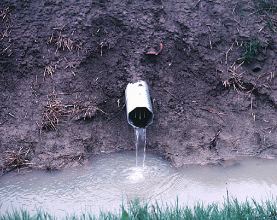Tile Drains a Significant Source of Phosphorus

Increased use of tile drains may be causing an increase in dissolved phosphorus loading. Photo from Purdue University.
The importance of agricultural tile drains as a contributor to water quality pollution is gaining more attention. In addition to its other provisions, the water quality bill recently passed by the House Fish, Wildlife and Water Resources Committee indicates some concern about agricultural tile draining. The bill calls for the Accepted Agricultural Practices to include requirements for reducing nutrient loading from tile drains, and calls for a report on the impacts of tile drains on water quality and means to mitigate those impacts. They are wading into a confusing but very important topic.
Tile drainage is a tool farmers use to drain water from their fields faster. They install perforated plastic pipes in trenches two to four feet below the surface. The pipes accumulate water and whisk it to a nearby outlet by a stream or wetland. Tiling allows farm fields to dry earlier in the spring and prevents excess water build up during wet periods.
On a field level, tile drainage changes the dominant flow pathway from overland to subsurface, sometimes by as much as 90%. This can lead to an up to ten-fold increase in soluble phosphorus loading.
Soluble phosphorus loading from agricultural fields has received little attention. For years scientists assumed the principal means by which phosphorus reached water bodies was attached to eroded soil particles. However, that equation can change dramatically with different soil types. Soils that crack develop preferential flow paths through which phosphorus-rich waters can reach below-ground tiles. Dissolved phosphorus also escapes soils that have low levels of aluminum or iron that otherwise bind phosphorus.
At long last the role of phosphorus loading in tile drains is getting increased attention. Tile drains were the subject of a cover story in the February issue of Crops, Soils Agronomy. The March-April 205 issue of the Journal of Environmental Quality will have a special section on the topic.
There has been a striking increase in soluble phosphorus loading to Lake Champlain. A similar trend has been seen in Lake Erie and in Europe’s Baltic Sea. Soluble phosphorus has often been associated with discharge from wastewater treatment facilities, but we know the increase is not coming from them.
“Subsurface transport (of phosphorus) is the weakest link in our assessment of the risk for phosphorus loss. So, we need to bring attention to this deficiency and advance our tools to predict it,” says USDA soil scientist Peter Kleinman, but it won’t be easy. “As we’ve tackled other problems, it has emerged as one of the most intractable things.”
In one Ohio study researchers found below ground loss of phosphorus to be low, amounting to about 2% of the fertilizer applied to land. Yet phosphorus concentrations in the tile drains were higher than for most wastewater treatment facilities. “So, from an agronomic standpoint, the farmer is doing great, but from an environmental standpoint, (the loss) is very significant,” said researcher Kevin King.
To further complicate matters, some of the farm practices used to prevent soil erosion can promote subsurface phosphorus loss. For example, cover crops are extremely effective at holding soil over the winter, but the freezing and thawing of the plant cells in early spring releases soluble phosphorus. No till agriculture also prevents erosion, but increases development of soil macropores through which soluble phosphorus might flow.
The Lake Champlain Basin Program’s recently passed budget includes funding for two projects related to tile drainage. One is a study of practices that can reduce phosphorus loading from already existing tile drainage systems. The second is an assessment of the extent of tile drainage in one sub-watershed of St. Albans Bay. Currently there is no tracking system for when, where, or how much tile is installed. LCC will have direct oversight of these two projects through our role on the Technical Advisory Committee. The results will be important for the legislature as they seek more information on tile drains in upcoming sessions.
